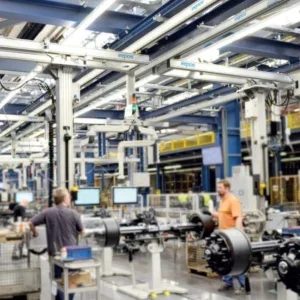He’s been making cranes for more than 50 years, but business isn’t what it once was. It’s getting more expensive to finance such companies in the United States, Pascuzzi says.
“We just have to pay a lot more money for everything we buy – hoists, forged steel, all the metals have gone up,” says Pascuzzi, 73. “(Plate steel) used to be 30 cents a pound; now we have to figure close to 80 cents a pound.”
The decline of manufacturing in the United States, changes in the global steel market and the high cost of fuel have taken 20 percent of his sales in the past few years.
“I think (steel prices) are levelling out right now,” Pascuzzi says. “Depending on the market, the demand will probably start going lower.”
The price of steel and fuel may rebound, but as manufacturing companies move outside the United States in search of cheaper labour costs, businesses such as Pascuzzi’s will continue to feel the pinch.
The company, with 20 employees, is one of the largest crane manufacturers in the area, making close to $4 million in annual sales. Despite the recent drop in sales, Pascuzzi hasn’t laid off any employees. “I try to run a pretty tight ship,” he says. “I’ve got people with a lot of longevity here. I can’t just run away from them.”
Pascuzzi began building cranes when he was 21. He worked in his father’s machine shop. His father, Gabriel Pascuzzi, an Italian immigrant, started the business in 1945.
“When I got out of the service in ’51, I went to work building cranes for my dad,” he says. “I liked it better than repairing old machinery. It was a lot cleaner, too.”
Pascuzzi offsets the slowdown in crane sales by focusing more on servicing existing cranes, he said. He also works more. Lately, he’s in the office six days a week.
Milwaukee Crane buys hoists from Columbus McKinnon, R&M, R Stahl, Ingersoll-Rand, Harrington, Morris/P&H, Spanco, Gorbel and Detroit, among others. He buys drives from Electromotive and stocks Alpha remote controls.
Capturing business requires a solid sales pitch, he says. “You have to convince people that spending a little more for quality will save them money in repairs.” Steel prices have been soaring the past few years because of increased global demand, especially in China, where manufacturing is booming because of cheaper labour costs and outsourcing by the United States. The growing economy allows the Chinese government to finance large infrastructure projects, such as dams, Pascuzzi says.
China consumes about 27 percent of all steel. By comparison, the United States, Canada and Mexico combined use about 15.3 percent, according to a report by the US-based International Iron and Steel Institute.
Despite the U.S. construction boom, less steel is being used to build industrial facilities in the United States because manufacturing is on the decline.
The use of steel for industrial construction has dropped from 12 percent of all steel construction in the late 1990s to four percent today, says John Cross, vice president of marketing with the American Institute of Steel Construction. “Tell him to ship his cranes to China – that’s where there’s a market,” Cross says, only half-joking.
Pascuzzi has no plans to ship his cranes overseas. He’s confident that steel prices will drop and customer loyalty will carry him through – for the short term, at least.
“Twenty years down the road, there will be fewer small manufacturers. We’ll have to resign ourselves to service or modernization of older equipment,” he says. The big guys will be making cranes as well as hoists, he predicts.
He recently sold a crane to Farwest Steel, a Eugene-based steel warehouse company with locations in five Western states.
Carl Hutchison, operations manager at Farwest Steel, chose Milwaukee’s bid over three others.
“They provide service after the sale of the crane – that’s important,” he says. “Some of their competitors come and go, but we’ve been doing business with them for 56 years. In that time, you build up some comfort and loyalty.”






